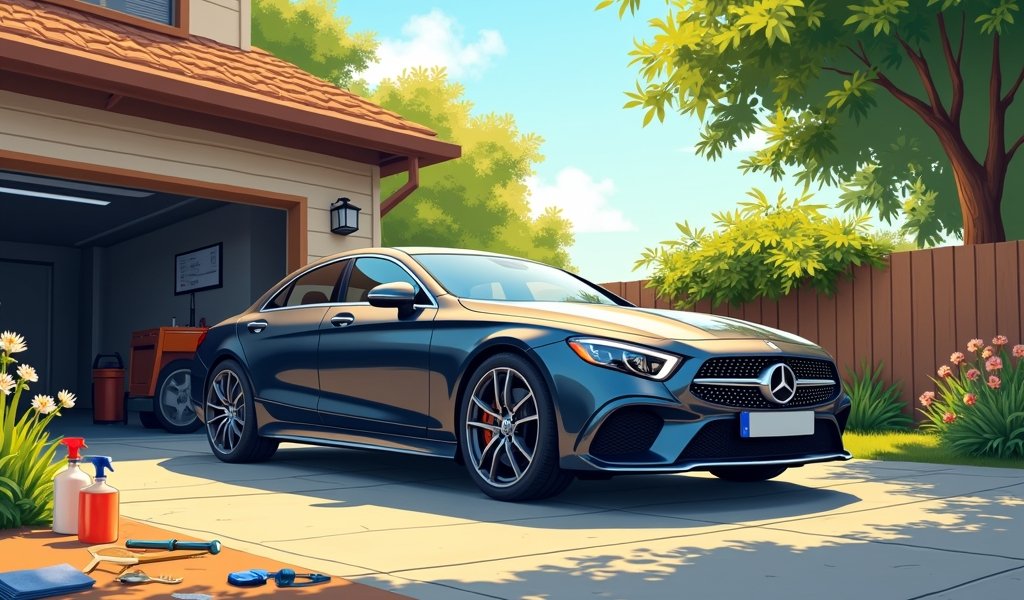Overview
This article provides seven essential summer car maintenance tips including cooling system checks, AC inspection, tire maintenance, battery protection, wiper blade replacement, paint protection, and brake system verification. Regular preventative maintenance on these critical systems can prevent breakdowns during hot weather, save on repair costs, and ensure safe, comfortable summer driving.
Table of Contents
- Checking and Maintaining Your Cooling System
- Inspecting and Replacing Air Conditioning Components
- Monitoring and Maintaining Tire Health
- Protecting Your Battery from Summer Heat
- Replacing Worn Wiper Blades and Fluids
- Protecting Your Paint and Exterior
- Checking Your Brake System
- Conclusion: Keeping Your Cool All Summer Long
- Frequently Asked Questions
Summer driving should be about enjoyment, not anxiety over whether your vehicle will make it through the heat. As a master technician with over 20 years under the hood, I’ve seen countless summer breakdowns that could have been prevented with some simple maintenance. When temperatures climb, your car faces unique challenges that don’t exist in cooler months. The good news? With a few targeted fixes, you can ensure your summer drives remain trouble-free.
Let me guide you through seven essential summer car care tips that will keep your vehicle running smoothly when the mercury rises. These aren’t complicated procedures – they’re straightforward preventative measures that can save you from costly repairs and roadside headaches during the hottest months of the year.
Checking and Maintaining Your Cooling System
Your vehicle’s cooling system is its first line of defense against summer heat. When outside temperatures soar, this system works overtime to keep your engine at its optimal operating temperature – typically around 195-220°F.
Start with a simple coolant level check. With the engine cool (never check a hot radiator!), locate your coolant reservoir. The fluid level should sit between the “min” and “max” lines. While you’re there, examine the coolant’s condition – it should be clear and free of particles, not rusty or oily.
The color of your coolant matters too. Depending on your vehicle, it might be green, orange, pink, or even blue. What’s important isn’t just the color, but whether it looks fresh. Degraded coolant loses its ability to transfer heat and prevent corrosion.
Here’s what to watch for that signals cooling system problems:
- Temperature gauge creeping higher than normal
- Sweet, syrupy smell (that’s leaking ethylene glycol)
- Visible puddles under your vehicle
- White steam escaping from under the hood
- Coolant warning light illuminating
Most manufacturers recommend a complete cooling system flush every 30,000-50,000 miles or every five years. If you can’t remember the last time yours was serviced, summer is the perfect time to address it. A cooling system failure in 90-degree weather can leave you stranded and facing a much more expensive repair than preventative maintenance would have cost.
For older vehicles, checking hoses and clamps is crucial. Squeeze your radiator and heater hoses – they should be firm but flexible. Soft, mushy sections or visible cracks indicate replacement is needed. And don’t forget your radiator cap – this pressurized component is often overlooked but critical to proper cooling system function.
Inspecting and Replacing Air Conditioning Components

Nothing sours a summer drive like a malfunctioning air conditioner. Beyond simple discomfort, a properly functioning AC system is a safety issue – it helps maintain driver alertness during hot weather.
Testing your AC is straightforward. Start your engine, set the AC to its coldest setting at maximum fan speed, and give it about three minutes to reach full cooling capacity. The air should feel noticeably cold – not just cool – and should flow consistently without unusual noises.
If your AC isn’t performing optimally, several issues could be at play:
- Low refrigerant level (commonly from small leaks)
- Clogged condenser (often from debris or insects)
- Failed compressor or compressor clutch
- Electrical problems with fans or sensors
- Blocked or dirty cabin air filter
The cabin air filter is something you can typically check and replace yourself. Located behind the glove compartment in most vehicles, this filter prevents dust, pollen, and debris from entering your cabin. A clogged filter restricts airflow, reducing AC efficiency and potentially causing musty odors.
For refrigerant issues, I recommend professional service. While DIY recharge kits are available, they can’t address the underlying causes of refrigerant loss. Modern vehicles use R-134a or R-1234yf refrigerants, which require specialized equipment for proper handling according to EPA regulations. Plus, overcharging can damage your compressor – an expensive component to replace.
Remember that running your AC periodically during winter months helps maintain seals and prevents issues when summer arrives. If you haven’t used your AC in months, don’t be surprised if it needs attention before peak performance returns.
Monitoring and Maintaining Tire Health
Heat is your tires’ worst enemy. Summer temperatures increase internal tire pressure and accelerate wear, especially if your tires are already low on tread. Underinflated tires flex more, generating additional heat that can lead to catastrophic blowouts on hot pavement.
Check your tire pressure monthly and before any long trips. For the most accurate reading, measure when tires are cold (before driving more than a mile). The recommended pressure is found on a sticker inside your driver’s door jamb or fuel door – not the maximum PSI stamped on the tire sidewall.
Don’t overlook tread depth. While the legal minimum is 2/32 of an inch, summer rain performance begins to degrade at 4/32 of an inch. The classic penny test works well: insert a penny into the tread groove with Lincoln’s head upside down. If you can see all of Lincoln’s head, your tread is dangerously low.
Summer is the perfect time for a rotation and alignment check. Proper tire maintenance not only extends tire life but also improves handling and fuel efficiency. Most manufacturers recommend rotation every 5,000-8,000 miles to ensure even wear.
Don’t forget to inspect your spare tire as well. Nothing’s worse than discovering your spare is flat when you need it most. Check its pressure and condition monthly along with your main tires.
If your tires are more than six years old (regardless of mileage) or showing uneven wear patterns, consider replacing them before summer road trip season. The date of manufacture is stamped on the sidewall as a four-digit code – “2518” means the 25th week of 2018, for example.
Protecting Your Battery from Summer Heat
While many associate battery problems with winter, summer heat is actually more damaging to battery life. High temperatures accelerate the chemical reaction inside batteries, causing faster internal corrosion and fluid evaporation.
Start with a visual inspection. Look for these warning signs:
- Corrosion on terminals (appears as a white or greenish powder)
- Bulging or cracked battery case
- Loose battery mount (allowing damaging vibration)
- Low fluid level (on batteries with removable caps)
Cleaning corrosion is a simple but effective maintenance task. Disconnect the battery (always negative terminal first, reconnect positive first), and use a solution of baking soda and water with a wire brush to neutralize and remove corrosion. Protective terminal spray or felt washers can prevent future buildup.
If your battery is approaching the four-year mark, consider having it tested before summer heat takes its toll. Most auto parts stores offer free battery testing. Look for a battery rated at least as high as your original equipment in terms of Cold Cranking Amps (CCA) and Reserve Capacity.
For those in extremely hot climates, battery insulation kits can help extend battery life by reducing heat exposure. These simple sleeves fit around your battery and can lower internal temperatures by up to 30 degrees.
If you’re experiencing slow engine cranking or dimming headlights when the AC is running, don’t wait for a complete failure. Battery problems rarely improve on their own, and replacement before a breakdown saves both time and stress.
Replacing Worn Wiper Blades and Fluids
Summer storms can be sudden and intense. Functional wipers are crucial for visibility during these downpours, yet many drivers neglect this simple maintenance item. Winter’s cold temperatures and spring pollen can degrade wiper rubber, leaving you with streaks and smears when you need clarity most.
Inspect your wiper blades for these signs of wear:
- Cracked or split rubber
- Frames that don’t maintain contact with the windshield
- Streaking or chattering during operation
- Squeaking noises when wiping
If you notice any of these issues, replacement is straightforward. Most auto parts stores offer free installation with purchase, but it’s a simple DIY job too. Consider upgrading to beam-style wiper blades, which withstand heat better and provide more consistent pressure across your windshield.
Don’t forget your windshield washer fluid. Summer driving means more bugs, road grime, and tree sap – all of which require proper cleaning fluid to remove safely. Use a summer-formula washer fluid designed to tackle these seasonal contaminants without leaving streaks.
While you’re at it, check all other vital fluids – brake fluid, power steering fluid, and transmission fluid. Heat accelerates fluid breakdown, so fluid that was “borderline” in cooler weather may fail when temperatures rise. Clear, clean fluid is essential for proper system function in all weather conditions.
Protecting Your Paint and Exterior

Summer sun is relentless on your vehicle’s exterior. UV rays fade paint and degrade plastic components, while heat bakes contaminants onto surfaces, potentially causing permanent damage.
Establishing a regular washing routine is your first line of defense. Aim to wash your car every two weeks during summer, more often if you’re driving on dusty roads or if your vehicle is parked under trees (bird droppings and tree sap are particularly damaging when heated).
After washing, apply a quality wax or sealant. Modern synthetic waxes and ceramic coatings provide excellent UV protection and make subsequent cleaning easier. For maximum protection, professionals recommend applying a new coat of wax every three months, though newer ceramic coatings can last significantly longer.
Don’t neglect your interior. UV-blocking window tint (where legally permitted) can dramatically reduce interior temperatures and prevent dashboard cracking and upholstery fading. If tinting isn’t an option, use a windshield sun shade when parked. A dashboard UV protectant applied monthly helps prevent premature aging of vinyl and plastic surfaces.
For convertible tops, special cleaners and protectants help prevent UV damage and maintain water resistance. Similarly, rubber seals around doors and windows benefit from silicone treatment to prevent drying and cracking in summer heat.
When possible, park in shade or garages to minimize sun exposure. If no shade is available, try to position your car so that the sun hits the rear window rather than the windshield – this keeps the driver’s area cooler for your return.
Checking Your Brake System
Your braking system faces unique challenges in summer months. Heat builds up naturally during braking, and this is compounded by ambient temperature. Brake fluid absorbs moisture over time, lowering its boiling point – a serious concern when components are already hot from summer driving.
Start with a visual inspection of your brake fluid reservoir. The fluid should be clear to amber in color – dark, cloudy fluid indicates contamination and needs replacement. Most manufacturers recommend changing brake fluid every two years regardless of mileage, as it’s hygroscopic (absorbs water from the air).
Listen for these warning signs of brake issues:
- Squealing or grinding noises
- Pulsation or vibration when braking
- Vehicle pulling to one side during braking
- Brake pedal feeling soft or spongy
- Longer stopping distances than normal
For those comfortable with basic maintenance, checking brake pad thickness is possible on many vehicles without removing the wheels. Look through the spaces in your wheel for the brake pad material – it should be at least ¼ inch thick. If you can’t see the pads or they appear thin, professional inspection is warranted.
According to the National Highway Traffic Safety Administration, brake problems contribute to approximately 22% of crashes where vehicle factors are cited as causes. Before any summer road trip, having your brakes professionally inspected can provide peace of mind and potentially prevent accidents.
Proper brake maintenance not only ensures safety but improves fuel efficiency. Dragging brakes from stuck calipers can significantly reduce your miles per gallon while simultaneously creating dangerous heat buildup.
Conclusion: Keeping Your Cool All Summer Long
Summer car care isn’t complicated, but it does require attention to systems that might not give you trouble in cooler months. The seven essential fixes we’ve covered – cooling system maintenance, AC inspection, tire care, battery protection, wiper replacement, exterior protection, and brake checks – create a comprehensive approach to summer vehicle health.
The best part? Most of these checks take just minutes and can save you hours of roadside frustration and hundreds (or thousands) in repair bills. Even if you’re not mechanically inclined, learning to spot the warning signs of potential problems empowers you to seek professional help before small issues become major headaches.
Remember that your owner’s manual contains specific recommendations for your vehicle. The maintenance schedule outlined there is developed by engineers who designed your car – it’s worth following their guidance, especially for seasonal transitions.
As temperatures rise, give your vehicle the attention it deserves. A little preventative maintenance now means more trouble-free summer drives ahead. After all, your summer should be spent enjoying the journey, not waiting for a tow truck.
Frequently Asked Questions
How often should I check my tire pressure during summer?
Check tire pressure at least once monthly and before any long road trips. Temperature fluctuations can cause pressure changes, so checking in the morning before driving gives the most accurate reading.
Will running my AC affect my fuel economy?
Yes, running your air conditioning can reduce fuel economy by up to 25% in extreme conditions. However, at highway speeds, AC is actually more efficient than driving with windows down, which creates aerodynamic drag.
How can I tell if my coolant needs to be replaced?
Look for coolant that’s discolored (brown or rusty) or contains floating particles. Most manufacturers recommend coolant replacement every 30,000-50,000 miles or five years, whichever comes first.
What’s the best way to protect my car’s paint from summer sun?
Apply quality wax or sealant every three months and park in shade whenever possible. Promptly remove bird droppings, tree sap, and insects, as these can etch into paint when heated by the sun.
Is it normal for my car to use more gas in summer?
Slightly reduced fuel economy is normal in summer due to AC usage and less dense warm air. You can minimize the impact by keeping tires properly inflated and removing unnecessary weight from your vehicle.

